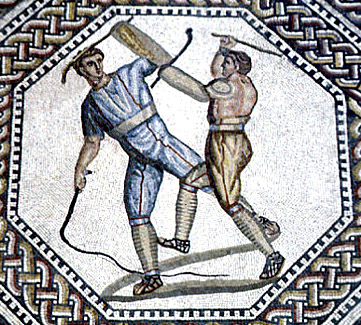

The munera began with an elaborate procession (pompa) that included the combatants and was led by the sponsor of the games, the editor or munerarius; in Rome during the imperial period, this usually was the emperor. The parade and subsequent events were often accompanied by music; this mosaic depicts a water organ and the curved horn (cornu) that accompanied the procession and various types of combat. The morning's events might begin with mock fights such as the contest between whip fighters (paegniarii) depicted below. These would be followed by animal displays, sometimes featuring trained animals that performed tricks, but more often staged as hunts (venationes) in which increasingly exotic animals were pitted against each other or hunted and killed by specially trained fighters called bestiarii. The lunch break was devoted to executions of criminals who had committed particularly heinous crimes—murder, arson, sacrilege. In the afternoon came the high point of the games—individual gladiatorial combats. These were usually matches between gladiators with different types of armor and fighting styles, highly trained professionals who fought for extremely high stakes.
